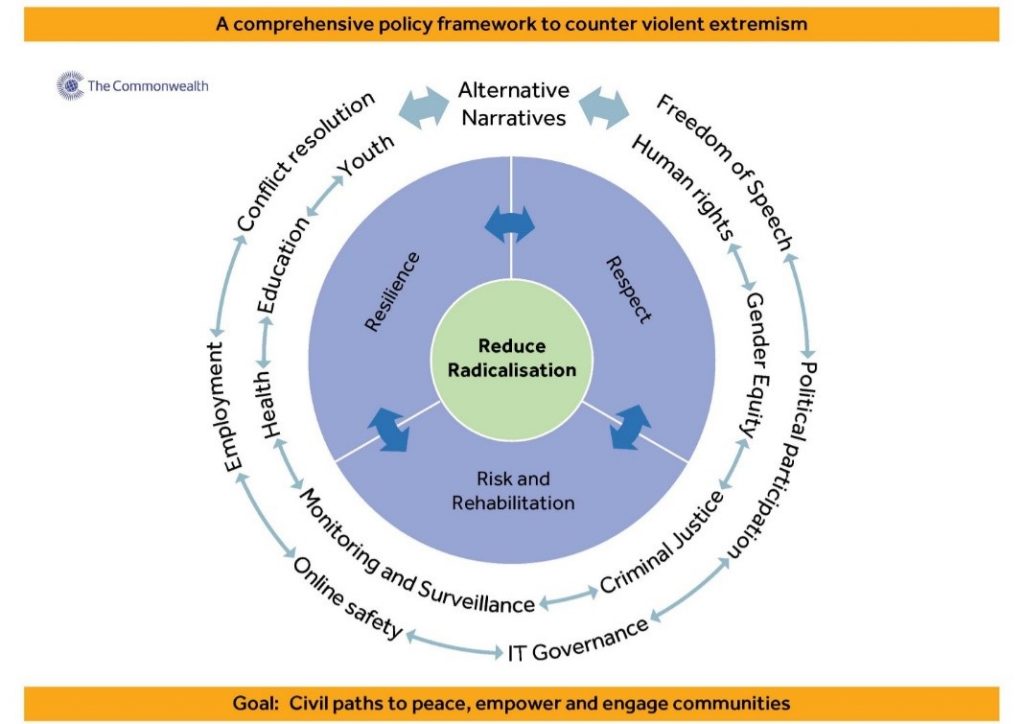[ad_1]
Context:
The recent arrest of multiple suspects in the ISI terror module case shows that the threat of radicalisation in India is pervasive and increasing exponentially.
A month before these arrests, a different ISIS module was busted by the National Investigation Agency.
The module was found to have a pan-India presence, stretching across Jammu & Kashmir, Karnataka, Maharashtra and Kerala.
In both cases, investigations have gone on to reveal that online radicalisation played an important role in the recruitment of members as well as the preparation and/or execution of extremist activities by the members.
Definition of Radicalisation:
Radicalisation is a process in which an individual or group adopts extreme political, social, or religious ideals and aspirations.
It rejects or undermine the status quo or contemporary ideas and expressions of the nation.
Recent rise of ISIS and its penetration across Asia is an example of such a radicalisation.
At the same time, it must be understood that radicalisation by itself is not bad and gains a positive or negative characteristic based upon its context.
A mere deviation from conventional thinking must not be penalised.
Radicalisation in India:
- The problem of radicalisation in India is well past its primary stages and has entered a second stage with more defined characteristics.
- We have enough evidence from reports of various investigative agencies across the country that the process is now subtle, systematic, organised, programmed and structured.
- Children face particular vulnerabilities as a result of armed violence such as orphanhood, psychological damage.
- They also face a threat of recruitment as young soldiers. These factors often lead to a disruption to education, and thereby the reduction of a child’s capacity to recover from poverty.
- Women are affected in many ways in the event of violence. Sexual violence, recruitment as combatants and an expanded economic/household role, which is often transferred onto young girls.
- Using resources for conflict-related purposes means that public expenditures on social services decrease. These impacts spending on social causes like education, health etc.
- So far, the Indian state’s response has been characteristically security-centric ranging from prevention of violent extremism, unlawful activities and terrorist acts by strengthening intelligence apparatus or through brute force or holding talks and initiating programmes aimed at the cessation of violence.
- However, it seems that these responses have come too late. It is pertinent to develop strategies before violence becomes the leitmotif of radicalisation.
Government Measures to combat Radicalisation:
The Ministry of Home Affairs had set up the Counter-Terrorism and Counter Radicalisation division in November 2017.
It can be gathered from the latest document on work allocation, that the focus of the division is largely on the implementation and administration of counter-terror laws and monitoring of fundamentalist organisations such as the Students Islamic Movement of India, Popular Front of India, Jamaat-e-Islami and Sanatan Sanstha.
The division was originally mandated with the task of developing policies and strategies to counter-radicalisation.
This should have been one of the major tasks of the agency. Yet, as per the document, the task of developing an action plan for counter-radicalisation and deradicalisation only forms a single point in a list of nearly 59 other tasks that the division is currently required to perform.
Need to define Radicalisation for whole world:
- There is also a need to develop a definition of radicalisation that suits the needs of such an action plan and is tailored to our particular context.
- This will allow the state to develop programmes and strategies to effectively combat such radical ideas, thereby addressing the problem of radically motivated violence.
- The definition of radicalisation would also help provide clarity as regards the purpose of implementation of the Action Plan.
- In SCO speech, Prime Minister Narendra Modi identified radicalisation as the greatest threat to the security and safety of all member countries.
- Asked the member countries to heed the challenges and build effective responses. Such responses can broadly be classified under the following heads — deradicalisation, counter-radicalisation, anti-radicalisation and disengagement.
- In line with this vision, India must lead by example and develop responses systematically with due regard to constitutional values.
Way Ahead measures:
- The Indian state should develop and enforce de-radicalisation, counter-radicalisation and anti-radicalisation strategies at a pan-India and pan-ideology level on a war footing.
- Such attempts must be informed by the fact that the battle against radicalisation begins in the minds and hearts much before it manifests in terms of violence.
- Any programme aimed at deterring or reversing radicalisation must focus on the ideological commitment that enables the violence, rather than the violence or the justification of violence itself.
- Efforts must be made to first stem the flow of propaganda from across the Indian borders.
- Second, a uniform statutory or policy framework to deal with radicalisation, de-radicalisation and its associated strategies should be developed.
- Third, arrested and convicted individuals must not only be prosecuted and punished as a measure of deterrence or retribution but their reformation and rehabilitation must also be prioritised.
- Fourth, counter-radicalisation strategies involving the rehabilitation, re-education and re-integration of those undergoing radicalisation must be developed and implemented.
- Fifth, anti-radicalisation measures aimed at the prevention of radicalisation must be executed.
- The last measure should include the promotion of the syncretic nature of religions in India through the development of counter-narratives, promotion of constitutional values and virtues, promotion of sports and other activities in schools and other educational institutions aimed at mainstreaming the youth.
Conclusion:
Radicalisation is a danger to internal security and polarises the Indian society deepening the sectarian differences.
Thus it is imperative to fight radicalisation on all fronts. A pragmatic and responsible civil society can ensure that Indian cultural harmony remains intact. Social security measures, speedy justice for poor can go a long way in strengthening it.
Radicalisation becomes problematic only where it has the propensity to lead to violence.
The challenge lies in preventing such radicalisation. Developing a nuanced understanding of the process of radicalisation as well as its characteristics can help guide the Action Plan in effectively meeting such challenges.
[ad_2]


